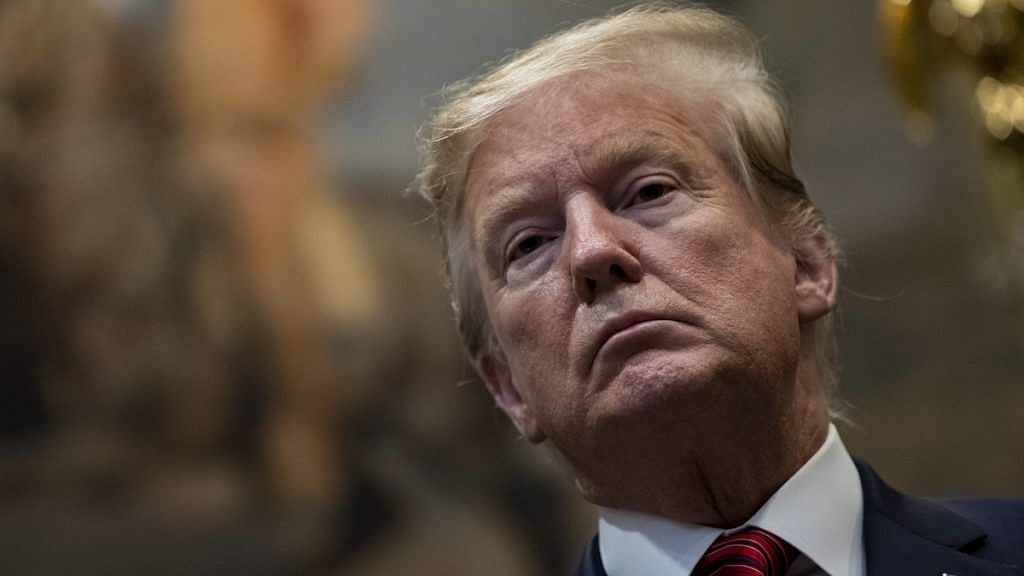The Donald Trump spectacle is now all set to engross India, swinging across Ahmedabad, Agra and Delhi in a span of 36 hours, generating sights of ‘adoring’ crowds, splendour of the Taj, and boisterously welcome official reception.
The already obsessive media coverage in the run-up to the visit reflects not just the US’ global, political and economic heft, or the excitement and entertainment by Trump’s unprecedented and erratic behaviour and policy-by-tweets, but also the people-to-people dimension of the relationship. Nearly 40 lakh Indian- Americans now call the US their home and 200,000 Indian students pay $6 billion annually as tuition fees in US universities seeking enhancement in life and economic status.
Also read: Trump visit not an empty spectacle without trade deal. He can still deepen defence ties
A continuity in India-US ties
The visit also reflects a certain continuity in the India-US relationship. Since the new phase was initiated through the Bill Clinton visit in 2000, US presidential visits have been in five-year cycles: George W. Bush in 2006, Barack Obama in 2010 and 2015, and now Trump in 2020. Each of these visits left their own legacy and marked decisive phases in cooperation.
Clinton’s had put an end to the phase of sanctions since our nuclear tests in 1998. Bush gave a push to the ongoing efforts to clinch a civil nuclear cooperation agreement, which was realised in 2008, and has since transformed the political, defence and technological collaborations. Obama, in 2010, declared support for India’s permanent membership of the UN Security Council. In 2015, he issued a Joint Strategic Vision for the Indian Ocean and the Pacific.
In the immediate post-Independence period, visits had been in 10-year cycles: Dwight Eisenhower (1959), Richard Nixon (1969), and Jimmy Carter (1978), and then there was a 22-year gap because the US remained preoccupied with the effort to push the Soviet Union out of Afghanistan, and the consequences in Europe after the dissolution of the Soviet Union. Each of those visits had their own peculiarities.
Eisenhower was welcomed by a crowd of five lakh in Connaught Place, and gave a positive feel for the relationship, otherwise marred by disagreement about Pakistan being armed through its involvement in US-led Cold War military alliances. Nixon’s was a damp squib; he was leaning towards Pakistan and not sympathetic to Indian concerns. Carter, with his focus on human rights, came recognising the vibrancy of Indian democracy, following the post-Emergency elections here, and change of government. Differences on his non-proliferation agenda and his comment caught inadvertently on an open microphone about sending a cold, blunt letter on return, took away some of the shine.
The Trump visit would need to be assessed in terms of the US’ and his own personal priorities.
Also read: India-US ties were paralysed 7 years ago. But Modi-Trump moved farther than others before
Trump’s personal priorities
Donald Trump gave a State of Union address on 4 February, which went down well with his base, and he sought to reach out to African-American and Hispanic communities. On 5 February, he was acquitted by the Senate, putting an end to the impeachment process initiated earlier in the House. After his visit to India, and the welcome by, inter alia, a crowd of “5-7 million”, he will project to his supporters that he also attracts international acclaim. There are not many countries globally where he would be welcomed in this manner.
Trump is popular in Israel, but with a total population of 80 lakh, it cannot compete in these numbers. The event in Ahmedabad will reinforce his outreach to the Indian-origin community in the US, which had been enthused by his extended presence at the 50,000-strong ‘Howdy, Modi!’ event in Houston in September. He will hope to gain more campaign funds and votes from the community, which has hitherto trended Democratic.
The US will hope to deepen further defence cooperation. An additional $3 billion of supplies, including military helicopters, are in pipeline. Agreement on trade appears to have stalled for now. On Afghanistan, India will be in wait mode as the current US effort with the Taliban plays out, seeing if it leads to enduring peace and reconciliation, or just a fig leaf for a US drawdown. Pakistan remains under pressure in FATF, but is in play in the Afghanistan context.
Also read: Trump’s India trip will feature a full stadium and mostly empty promises
A successful visit
The real elephant (or dragon) in the room will be the Trump Administration-led effort for a global push back on China’s growing international footprint, technology and infrastructure acquisitions, trade and investment practices, and challenge to international rules and norms. The US is campaigning to get others to not use Huawei in 5G. It has clamped down on Chinese access to US universities and labs. It has declared several Chinese media entities in the US as ‘foreign missions’, asserting their being under Chinese government control. Secretary of State Mike Pompeo has called out the Chinese Communist Party. The overall message from the US is that it has woken up to peer competition from China, embodying a different model of governance and established rules and norms. The manner in which this rivalry plays out will pose challenges and opportunities to others.
The Trump visit will be successful. Individual preferences matter. Leaders make a difference. India will have invested in someone, who with all his unpredictability, will be around in decision-making authority, with global impact, for at least one, and possibly five, more years.
At the same time, India will also need to be sensitive to the toxic political atmosphere in Washington, and not lose sight of the need to sustain the bipartisan support that has propelled the relationship, especially since the civil nuclear cooperation agreement in 2008.
The author is former Ambassador to the US and involved in dealing with Afghanistan and Pakistan in the post-9/11 period. Views are personal.
